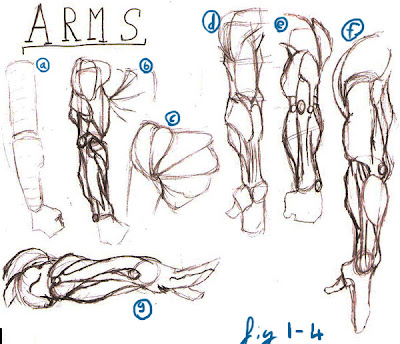The purpose of this test is to gain a better understanding of the positions of the muscles in the arm and how they attach to the shoulder.

The above images use the aforementioned tube-form technique (see image [a]) as a base. David Finch doesn't know the names of all the muscles in the body and builds the muscles in relation to each other creating flow through a figure as in image [b]. The chest and shoulder muscles that attach the arm to the body start at the same place and fa
n-out as in image [c]. David describes the muscles as inter-connecting footballs (American footballs) demonstrated buy image [d]. Once an understanding of where the muscle shapes are in relation to each other was achieved the tutorial continues by rotating the arm so the muscle shapes can be seen from different views. The circles in image [e] represent where the tendons attach the muscle to the bone in image [e] the three bones of the elbow are visible as is the protruding bone in the wrist. Image [f] shows the muscle flow from the side and image [g] shows the arm raised from the side of the body.

^^Screenshot from DVD^^
Strengths
The advantages of the tube-form under-sketch are apparent in these images by using the larger shapes to get the proportions correct then breaking them down into smaller detailed muscle shapes. The technique of drawing the muscles in relation to each other and not drawing each one individually which can cause the muscles to look disconnected, By drawing them in relation to each other creates flow and makes the muscles look connected rather than floating.
Weaknesses
No comments:
Post a Comment